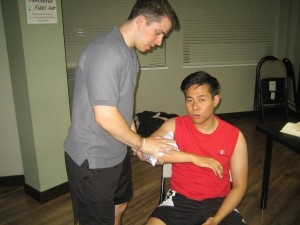Biceps tendon tears can arise either at the elbow or shoulder. Generally, a tear might be partial or complete. If a full tear develops, the tendon has ripped apart from the bone.
When it comes to serious or continuous overuse, the tendons might end up frayed and later tear. The tendon might even tear as part of an injury especially when moving or bending the elbow or shoulder in an awkward position or falling with the arm extended. It is important to note that the biceps tendon usually tears when lifting heavy objects.
Indications

The characteristic indication of biceps tendon tear is abrupt, intense pain in the upper region of the arm or at the elbow, depending on the tendon that is damaged. The individual might hear or feel a “pop” as the tendon tears.
Other indications of biceps tendon tears might include:
- Piercing pain at the elbow or shoulder
- Bruising that appears on the upper arm or forearm close to the elbow
- Sensation of weakness in the elbow or shoulder
- Difficulty rotating the arm from palm down to palm up position
- Changes in the contour of the front part of the bicep in the upper arm
Even though surgery might be required to repair a torn tendon, an individual with a torn tendon might be able to function normally. The symptoms can be alleviated with the same treatment options used for tendonitis.
Management
The non-surgical treatment might be considered for the elderly and less active individuals or if the injury occurred in the non-dominant arm. These measures might also be an option for individuals with medical ailments that puts them at high risk for complications from surgery.
- Rest – avoid heavy lifting and overhead activities to reduce the pain and swelling. A sling might be suggested by the doctor to be used for a brief time.
- Non-steroidal anti-inflammatory drugs (NSAIDs) – these medications are given to reduce the pain and swelling.
- Physical therapy – once the pain allows, the doctor might recommend rehabilitation exercises to strengthen the adjacent muscles to restore as much movement as possible.
Disclaimer / More Information
The information posted on this page on biceps tendon tears is for learning and educational purposes only. To learn to manage this type of tendon injury, register for first aid training at one of our training centers located throughout Canada. The training centers are in Edmonton, Calgary, Vancouver, Kelowna, Saskatoon, Victoria, Surrey, Mississauga, Winnipeg, Red Deer, Toronto, Ottawa and Halifax.
